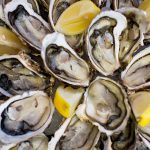 Although ostracism and Osterizer both resemble the word oyster, only one of them is actually related to the name of that tasty mollusc. The ancient Greek word for oyster was ostreon, a word that derived from an Indo-European source meaning bone. From the same Indo-European source developed the Greek word os, meaning bone (as in osteopath), and the Greek word ostrakon, a word denoting shell-like fragments of broken pottery. Far from being trash, such pottery fragments were useful because they could be written on, as they were when the members of the Greek assembly cast their votes on whether some troublemaker should be sent into exile; if, after counting, enough of the pottery shards had been inscribed with the unpopular fellow’s name, he was banished from the state for ten years. This process became known as the ostrakismos, which became the English ostracism in the sixteenth century, about two hundred years after the word oyster was adopted in the mid fourteenth century. The food processor known as the Osterizer, on the other hand, takes its name from the man who patented it, John Oster; Oster’s ancestors acquired their surname not because they were molluscs, but because they were hostlers, people who looked after the horses belonging to a hotel’s guests.
Although ostracism and Osterizer both resemble the word oyster, only one of them is actually related to the name of that tasty mollusc. The ancient Greek word for oyster was ostreon, a word that derived from an Indo-European source meaning bone. From the same Indo-European source developed the Greek word os, meaning bone (as in osteopath), and the Greek word ostrakon, a word denoting shell-like fragments of broken pottery. Far from being trash, such pottery fragments were useful because they could be written on, as they were when the members of the Greek assembly cast their votes on whether some troublemaker should be sent into exile; if, after counting, enough of the pottery shards had been inscribed with the unpopular fellow’s name, he was banished from the state for ten years. This process became known as the ostrakismos, which became the English ostracism in the sixteenth century, about two hundred years after the word oyster was adopted in the mid fourteenth century. The food processor known as the Osterizer, on the other hand, takes its name from the man who patented it, John Oster; Oster’s ancestors acquired their surname not because they were molluscs, but because they were hostlers, people who looked after the horses belonging to a hotel’s guests.
A shellfish that, when eaten raw or only partially cooked, may be a source of hepatitis A virus and bacterial pathogens.
Oysters are a type of mollusk possessing a coarse, jointed, dual shell, and delicate, typically white or grayish flesh that is enjoyed in a multitude of preparations. These delectable sea creatures come in varying sizes, shapes, and textures, ranging from plump to flat and exhibiting a wide range of flavors and tenderness. In the United States, approximately ninety million pounds of oysters are consumed annually.
Encounter the captivating bivalve mollusk adorned with a rough, flat gray shell—the oyster. These delightful delicacies grace our palates from September to April, showcasing their seasonal splendor. Oysters are known to inhabit river mouths and bays along the shoreline, with cultivated varieties reared in special beds. The world of oysters boasts a diverse array of species. In the United States, four types take center stage. The Eastern, or American, oyster thrives along the Atlantic coast and embraces various regional names such as Blue Point, Wellfleet, Chincoteague, and Malpeque. On the West coast, one can relish the tiny Olympia oyster and its larger counterpart, the Pacific or Japanese oyster. Additionally, the French Belon oyster has recently found cultivation grounds in Maine, further expanding the delightful array of oyster offerings.
